Travel trends shift overnight, conferences get canceled, and weather forecasts change plans. Hotels that thrive aren’t guessing – they’re leveraging advanced revenue management strategies to stay profitable, optimize pricing, and convert uncertainty into opportunity. This article explores the key strategies, metrics, technologies, and challenges that define modern revenue management in 2025 and beyond.
What is Hotel Revenue Management?
Robert G. Cross, the author of Revenue Management: Hard-Core Tactics for Market Domination defines revenue management as “the art and science of predicting real-time customer demand at the micromarket level and optimizing the price and availability of product.”
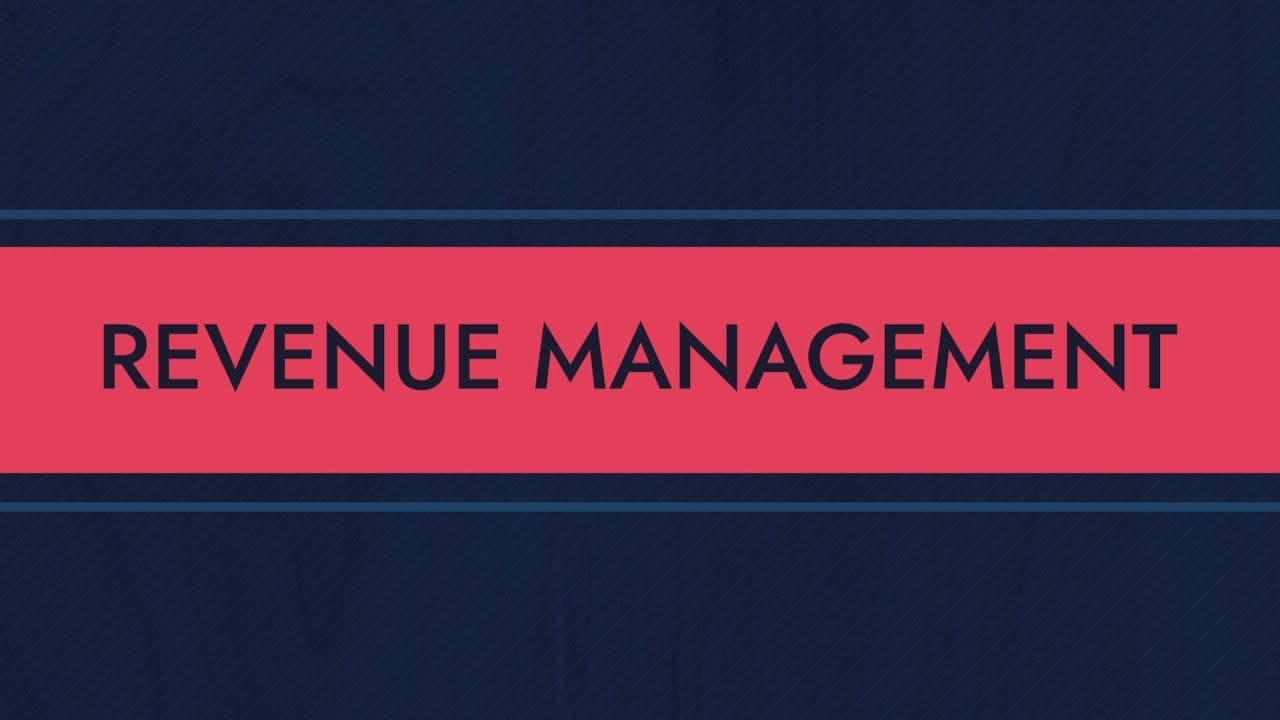

How revenue management works
Simply, revenue management means predicting consumer behavior to sell the product at an optimal price every day. Therefore, the definition of hotel revenue management is straightforward: selling the right room to the right client at the right moment at the right price on the right distribution channel with the best commission efficiency. Sometimes revenue management is called yield management, but these terms aren’t interchangeable.
Revenue management vs yield management
Revenue management and yield management both refer to distinct strategies in the hotel industry.
Yield management is a tactical approach aimed at maximizing revenue from a fixed, perishable inventory – hotel rooms – by adjusting prices based on real-time demand and booking patterns. It involves
- dynamic pricing – adjusting room rates in response to fluctuations in demand, seasonality, and booking lead time,
- inventory control – implementing booking restrictions such as minimum or maximum length of stay, and closed to arrival policies to optimize occupancy and revenue, and
- segmentation – differentiating pricing based on customer behavior and willingness to pay.
Revenue management, on the other hand, is a broader, more strategic approach that includes yield management techniques but extends to overall business optimization. It involves
- data-driven decisions – using historical data, market trends, and customer insights for pricing and strategy,
- multi-channel revenue – optimizing not just room rates but also ancillary services like dining and events,
- forecasting & planning – taking a long-term view of demand, seasons, and market shifts.
In short, yield management is a subset of revenue management. In 2025, it’s largely considered outdated in professional hotel revenue management circles since it focuses primarily on room inventory and occupancy, with less emphasis on total revenue or profitability.
Why is revenue management important for hotels?
A hotel room is a perishable product – once the night is over, an empty room’s potential revenue is lost forever. This principle drives many RM tactics: there’s urgency to sell today’s inventory (rooms for tonight or a future date) before it perishes. The nature of rooms is what differentiates hotels (and airlines, car rentals, etc.) from say retail: You cannot stockpile a room night and sell it later.
That’s why it’s so important that hotels adjust room rates and forecast demand to plan accordingly, reducing the risks of under- or overbooking.
Hotel revenue management strategies
Effective revenue management relies on a mix of strategies that allow hotels to adapt to fluctuating demand, maximize profitability, and serve diverse guest needs. Below are the most impactful approaches used today.
Dynamic pricing
Dynamic pricing is about changing the room rates regularly (sometimes multiple times per day) according to market demand.
Dynamic pricing strategies are built around selling the property for the best price possible. They are based on supply and demand ratio, as well as external and internal data. External data includes such data points as competitors’ prices, weather data, and booking patterns; while internal data includes segmentation, customer profiles, rates, etc.
Dynamic pricing strategies allow hotels to keep up with the market and maximize occupancy rate, as well as the other hotel revenue management KPIs (we’ll talk more about them in the next section).
Make sure to read our piece about dynamic pricing for more detail into the approach and technologies.
There are two approaches within dynamic pricing: the traditional BAR method and open pricing.
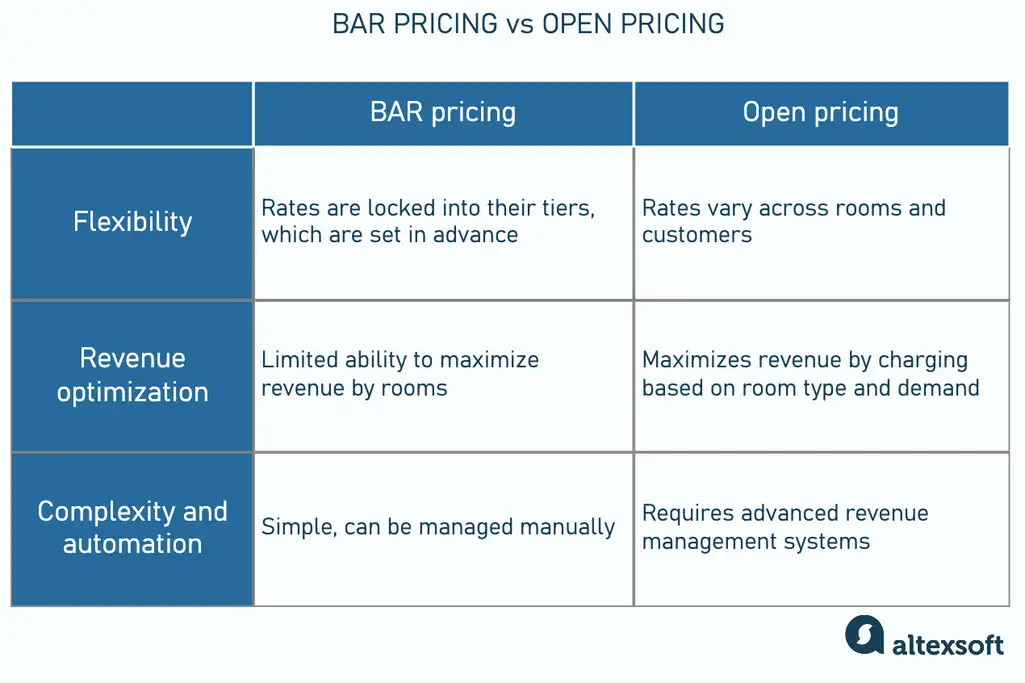
Main differences between BAR and open pricing
BAR (Best Available Rate), or rack rate, is the base dynamic price for a standard room. Other room types are priced by adding fixed or percentage modifiers, while discounts are calculated as percentages off the BAR. Although BAR adjusts in real time with demand, related rates remain fixed to it.
Instead of tying all rates to BAR, you can use open pricing – setting flexible discounts and room prices by demand, channel, and guest segment. This allows granular, dynamic price points rather than a few rigid tiers, making the hotel more competitive and responsive in real time.
Imagine a guest booking a suite. If the Best Available Rate is $200 for a standard room, the suite is always 20% more – $240. Even if demand is high and people would pay $300, the suite is capped at $240.
Now picture the same guest on the open pricing approach. The standard room might be $150, but the hotel can still price the suite at $240 or even $300 if demand is strong. If business is slow midweek, they could drop the suite to $210 to encourage longer stays.
We explain everything about hotel rates in a separate post. Also, feel free to explore our article about open pricing as it dives deeper into its pros, cons, and implementation.
Distribution and inventory management
Managing distribution channels is crucial for maintaining profitability. Hotels must balance third-party platforms like OTAs with direct bookings. For instance, OTAs offer broad visibility but come with commission costs, while direct channels (websites, mobile apps, call centers) deliver higher margins and better customer data but require investment in marketing and technology.


OTAs and Hotels: The invisible battle over hospitality market
Maintaining rate parity across these channels is equally important, as inconsistent pricing can erode trust and reduce conversion rates (see our article on rate parity to learn about this important principle).
Modern hotels increasingly focus on channel mix optimization, using data to determine the ideal allocation of inventory across multiple sales channels. For example, hotels may prioritize OTA listings for last-minute bookings or international markets, while directing loyal guests and returning visitors to the website for premium offers or packages.
Say, a mid-sized resort in Spain noticed that OTA bookings were filling 60 percent of rooms, but margins were thin due to commissions. By investing in a mobile-friendly website and targeted email campaigns, the resort increased direct bookings by 25 percent within six months, capturing higher revenue per guest. Meanwhile, OTAs continued to serve last-minute international travelers, ensuring occupancy remained high during slower periods.
Optimizing distribution is only part of the puzzle – hotels also need to manage their inventory strategically to ensure every room contributes to revenue.
While pricing often gets the spotlight, even the smartest rates mean little if rooms aren’t allocated and controlled strategically. Hotels don’t just sell “rooms” – they sell a perishable inventory of room types, views, packages, and distribution channels that expire at midnight every day.
Effective inventory management means deciding
- how many rooms to sell through each channel (direct website, OTAs, corporate accounts, wholesalers),
- which room categories to open or close on given dates, and
- how to balance short-stay vs. long-stay bookings to maximize occupancy and revenue.
Modern revenue management systems use AI and demand forecasting to dynamically adjust availability across channels in real time, preventing overbooking while ensuring no revenue opportunity is left on the table.
Demand forecasting is the analysis of information about past demand, as well as current and future events across all the customer segments. Based on this data, you can predict when the demand will increase or decrease, and develop the right pricing, marketing, and distribution strategy.
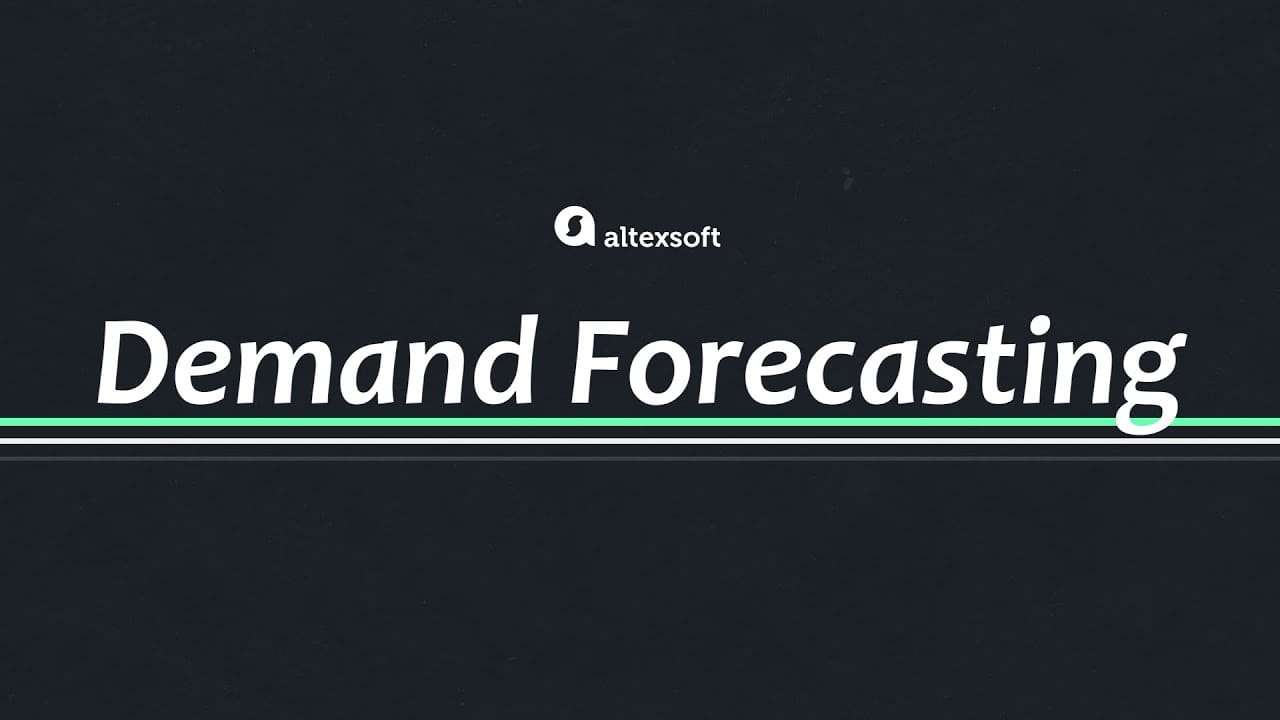

Demand forecasting: how predictive analytics helps plan for the future
This part of revenue management is especially important because it serves as a basis for setting prices, choosing distribution channels, creating promotions to engage more guests, or launching other marketing activities to increase occupancy. To learn more, visit our post about machine learning approaches to price forecasting.
There are some of the tactics and tricks you can use to play around with your inventory and maximize revenue.
Room allocation and stay restrictions
One of the main tactics to control inventory is length of stay (LOS) control, which involves setting restrictions to maximize revenue per room over a given period. For instance
- minimum LOS means requiring a two-night minimum stay during high-demand events helps avoid selling out on peak nights while leaving shoulder nights empty, and
- maximum LOS means that in periods of expected high demand, capping the number of nights booked ensures more guests can access inventory.
When applied strategically, LOS rules protect availability, boost occupancy across multiple days, and optimize average daily rate (ADR), which we will talk about later in the article.
Other approaches include:
- Closed to arrival means that no reservations are allowed with arrival on a particular day. It can be applied to lighten the workload of the front desk team on a busy day but is definitely risky as it can turn away some of the guests.
- Allotment is giving your partners (such as wholesalers, travel agents, or event organizers) a pre-negotiated number of rooms to sell, often at a discounted rate.
- Last room availability relates to a contract between a company and a hotel that fixes the room rate. It is done to support last-minute reservations for business trips and guarantee room availability for a pre-negotiated price.
Targeting multiple customer segments
Customer segmentation is an important part of marketing and pricing as it allows you to define groups of travelers that visit your hotel and address them differently. For example, business travelers have different needs and preferences than backpackers on a budget, so you have to know your customer and be ready with the offers that fit each group.
Each customer group provides opportunities to gain extra profit -- if you do it right. For example, you might offer discounts to your loyal customers, create tour packages for families, or negotiate rates with companies that have many business trips.
Further analysis can help you discover important trends in customer behavior. You might find out that some customer groups have a high rate of cancellations or no-shows, so it makes sense to focus your marketing efforts on other segments.
Applying various pricing techniques
There is a wide variety of other pricing tactics that can be implemented (often in conjunction with one another).
Length of stay pricing can refer to either setting a minimum visit duration (can be effective during high-demand period) or offering a lower rate for longer stays (say, set a discount for reservations of more than 4 nights). The latter not only ensures higher occupancy, but might also lead to higher ancillary revenue.
Packages and value-added pricing is offering a bundle or package of services at discounted rates. You can include other hotel services in such packages (e.g., airport transfer, meals, spa, etc.) or partner with external providers (such as car rentals or tour agencies) to provide guests with special deals.
Cancellation policy can also impact your pricing strategy. For example, you offer higher prices with an opportunity to cancel the reservation and get a refund and vice versa.
Segment based pricing is setting different rates for different guest segments. For example, you can offer special rates or create special offers for those who book directly through your website (read on to learn more about the importance of encouraging direct bookings).
Exclusivity vs affordability are two opposite approaches when you either position yourself the highest (most exclusive) or the cheapest on the market. Depending on your property, you can promote yourself as a luxury place and target top-shelf travelers or as an affordable place for price-sensitive guests. Note that in the first case, it’s important to create and maintain an excellent reputation and also to be fully transparent with what you offer, letting your guests understand what they are paying for. In the second case, remember about the break-even point and don’t let high occupancy with low prices lead to losses.
Usually, a revenue manager is the person in charge of deciding on a pricing strategy. Let’s look closer at the revenue manager’s role and tasks.
Who is a revenue manager? Job description
A hotel revenue manager has a long list of responsibilities that largely match the main elements of revenue management that we described above. To achieve best results, this specialist must cooperate with all hotel departments, especially sales and marketing teams to push the hotel business forward.
So, the main activities of a hotel revenue manager revolve around the following.
Forecasting is based on data and segmentation, the main pillars supporting revenue management. Predicting customer behavior enables a revenue manager to optimize revenue. The primary intelligence is derived from historical data on occupancy, room rates, previous revenue, and the current data on customer activity.
Pricing depends on market demand and customer desire to pay for a particular type of property. To set the price, a revenue manager analyzes the market, competitors’ prices, and their products. The prices are optimized according to different pricing strategies.
Inventory management. Since one of the main tasks of a revenue manager is to make sure that all the rooms are occupied, he or she sets the entire marketing, pricing, and distribution strategy to maximize occupancy.
Distribution channel management. Building a distribution strategy is one of the core activities of inventory management. Channels are often closely tied to the customer segments that use them, so depending on the product type, a revenue manager can choose a channel and set prices for a particular segment of a target audience.
Marketing. The goal of any marketing activity is to increase the volume of sales. It uses the tools that allow a property to sell all the inventory by keeping customer flow steady and attracting new guests. This includes such marketing activities as promotions, discounts, and loyalty programs. So a revenue manager has to work closely with the marketing team to align their efforts with the overall strategy.
If you are a hotel owner who is considering hiring a revenue manager or someone looking for this position, you have to understand that this is a highly analytical role requiring a strong statistics or math foundation. Specialized training and a dedicated degree or certification are good ways to prove qualifications. Some top-notch schools offering best-in-class education are
A good skill set can be obtained not only through a full-fledged degree program, but also with the help of specialized certifications or even online courses. Here are some widely recognized options you can trust:
- Hotel Revenue Management Certification Program from Cornell Nolan school,
- CRME from HSMAI Academy,
- CRM from HSMAI Academy,
- CHRM online program from AHLEI (American Hotel & Lodging Educational Institute), and
- Hotel Management specialization by ESSEC Business School via Coursera.
A specialist in revenue management should be able to perform the following tasks:
- Market analysis and segmentation,
- Competitor analysis,
- Customer behavior analysis,
- Historical and current data analysis,
- Yield management,
- Revenue performance forecasting,
- Daily and monthly reporting, and
- KPI tracking.
The last point is of special importance, because the KPIs define the success of the whole strategy and highlight the possible weaknesses and areas for improvement. Let’s look at the main ones used in the hospitality industry.
KPIs in hotel revenue management
Traditionally, the effectiveness of revenue management strategy is measured using the following KPIs.
Occupancy rate – the number of occupied rental units at a given time, compared to the total number of available rental units at that time.
Occupancy rate = Rooms sold / Room available
Average daily rate (ADR) – this rate is applied to a room’s average rental income during a certain period of time. It’s compared to the hotel’s historical ADR or competitors’ metrics.
ADR = Rooms revenue earned / Number of rooms sold
Revenue per available room (RevPAR) – a KPI that assesses financial and business performance of a hotel. RevPAR measures the ability of a property to fill all the rooms and define the best price for them. There are two ways to calculate it:
RevPAR = Rooms revenue / Rooms available
RevPAR = Average daily rate * Occupancy rate
Total revenue per available room (TRevPAR) – a metric that assesses total revenue, generated by the property, including additional revenue streams. This KPI captures a snapshot of overall business performance. TRevPAR is one of the main benchmarking tools for big hotels and resorts.
TRevPAR = Total revenue / Total number of available rooms
Net revenue per available room (NRevPAR) – a KPI that includes spendings on marketing and distribution in the calculation. It allows hotel revenue managers to measure the impact of distribution costs on the room revenue.
NRevPAR = (Room revenue – distribution costs) / Number of available rooms
Gross operating profit per available room (GOPPAR) – measures the profit of a hotel and value of all assets at any given time. GOPPAR measures profit to capacity, including all the hotel’s expenditure.
GOPPAR = Gross Operating Profit / Number of available rooms
Average Length of Stay (ALOS) – a KPI that shows the average number of nights guests stay at a hotel during a given period. ALOS helps revenue managers understand booking behavior, optimize pricing and packages, and plan inventory allocation more effectively.
ALOS = Total number of room nights / Total number of bookings
Cancellation rate and No-Show rate – KPIs that indicate the percentage of reservations that are canceled or not honored by guests. High rates can distort forecasts, reduce occupancy, and increase dependency on overbooking strategies. Monitoring these metrics helps hotels adjust cancellation policies, improve demand forecasting, and protect revenue.
Cancellation Rate = Number of canceled reservations / Total reservations
No-Show Rate = Number of no-shows / Total reservations
Pickup / Booking Pace – a KPI that tracks how quickly reservations are made for a particular date or period. Pickup and pace analysis allows revenue managers to spot demand trends, identify booking windows, and adjust rates or restrictions accordingly.
Pickup = Reservations on hand today – Reservations on hand yesterday (for the same date of stay)
Booking Pace = Number of bookings received over time until arrival date
A revenue manager’s task is to track these KPIs and develop a strategy to improve the metrics, making the hotel a successful business. A hotel revenue manager has to deal with multiple reports and data. Specialized software can save time and resolve some issues. In the next section, we’ll look closer at some of those systems.
For a fuller list and more detailed descriptions, check our article on hotel metrics and KPIs.
Hotel revenue management systems
Even today, in the world of global digitization, a revenue manager spends most of the time managing reports manually, rather than analyzing them and working on an effective pricing strategy. Automated revenue management software can facilitate everyday manual tasks that he/she performs.
Hotel revenue management software helps setting the best prices for hotel rooms, based on data and helps generate dynamic offers. Typical features are
- Detecting the most profitable pricing options,
- Demand forecasting,
- Analysis of lost revenue due to overbooking or cancellations,
- Revenue reports by KPIs,
- Collection of historical inventory data,
- Channel- and segment-based revenue analysis, and
- Day- or week-based performance analysis.
The software can consist either of several modules or be oriented to particular revenue management tasks.
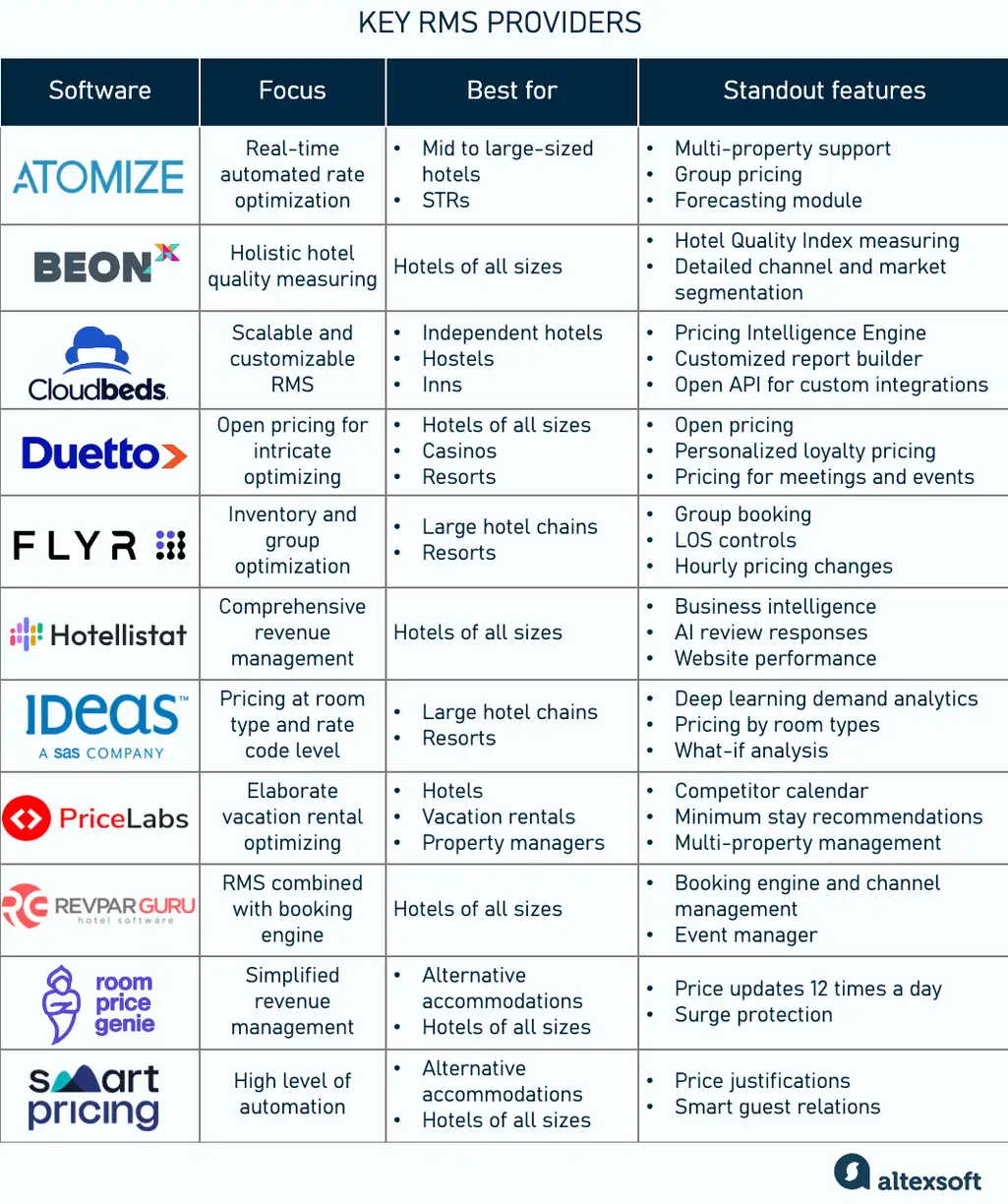
A general overview of the top revenue management system providers
Please, read our article describing and comparing the most popular RM systems on the market, and tips on selecting one.
Best practices in a hotel revenue strategy
Although hotel revenue management doesn’t evolve fast, strategies aimed at improving it develop in tandem with modern business and technological trends. Here are some practices that hotels use to improve revenue.
1. Shift from RevPAR to profit management
For a long time Occupancy rate, ADR, RevPAR, and NRevPAR were the most important KPIs in hotel revenue management. They measured business success and were compared to the same metrics of competitors, but today's paradigm is different.
As highlighted by HSMAI APAC, RevPAR is an outdated metric – it doesn’t show how much money actually stays with the hotel after costs. The focus is shifting to understanding the net profit per booking.
The Profit-Oriented Revenue Management (PORM) framework stresses evaluating channel and guest segment profitability – not just volume – so hoteliers can make smarter pricing decisions and investments
Compared to the other KPIs, GOPPAR and TRevPAR draw a broader picture of business performance. This means that a revenue manager focuses not just on a single parameter that relates to the occupancy, but the value of a room in the global economic prospects of a hotel. Another significant metric is NRevPAR (net revenue per room), because it allows revenue managers to account for expenses in their calculations.
2. Perform channel and overbooking management
Revenue highly depends on the channels that guests use for booking. Channel management influences revenue management, preventing overbooking and managing customer bookings sources. Channel management software, like SiteMinder, AxisRooms, or ChannelRUSH, automatically updates information about the available rooms across all the channels to avoid double bookings. But there are situations when overbooking can benefit the revenue of a hotel. Let’s see how.
A revenue manager must analyze daily statistics by channel to understand where the bookings come from and watch the sources of double bookings to close sales on these channels. Sometimes a couple of overbookings won’t matter if a cancellation is predicted. In case there isn't a cancellation, a hotel can either send a guest to another hotel, provide compensation, or offer a future discount, which costs much less than a room without a guest.
Selling slightly more inventory than is actually available can be a good revenue management strategy. For instance, it’s widely used by US airlines. Cancellations and no-shows, which always happen, lead to empty rooms. Overbooking strategy can maximize total capacity and increase revenue. In case of no-shows or cancellations, a hotel manager still can fill a previously booked room. Based on historical data of cancellations and no-shows, a revenue manager in cooperation with a front desk can distribute more property in a certain period of time to avoid unoccupied rooms.
3. Drive direct bookings
Bookings that come from a direct channel increase RevPAR, remaining an effective distribution channel. At the same time, OTAs are growing more popular, making hotels visible to a larger number of travelers worldwide – for instance, OTAs account for one fifth of the total travel market and a half of the online market in the US. But there is something that makes it less great: rate parity.
A legal agreement obliges a hotel to keep prices the same across all distribution channels. It means that regardless of the channel a person uses to book, via an OTA or directly at a hotel, it makes no difference to him/her because this traveler gets the room for the same price. But it does make a difference to the hotel by forcing it to pay a commission to an OTA.
Decreased spendings on OTA commissions allows for maximizing revenue, but here is the problem: how to encourage the travelers to book directly? First, by offering comps like free Wi-Fi, breakfast, or a discount for a direct booking.
Second, you can improve your website. In an increasingly competitive hospitality industry, a hotel website must be user-friendly and equipped with a robust booking engine to enable your guests to make reservations easily and provide opportunities for upselling. Also, make sure your website is optimized for search engines and mobile channels. That is how travelers will find your property faster if they are looking for a room in your area.
You can learn more about driving direct bookings back to your website in our dedicated article. Also, be sure to check the success stories of some famous hotel brands as a real-world example of implementing direct booking strategies.
4. Adopt AI-powered technology
Predictive AI has become the backbone of modern revenue strategy, transforming how hoteliers plan, price, and personalize. By analyzing vast streams of real-time data – everything from booking patterns and competitor rates to flight schedules, weather forecasts, and even major local events – AI can anticipate demand shifts days or weeks before they appear in traditional reports.
For example, a predictive system might flag an unexpected surge in flight arrivals or trending social media chatter about a festival in the city. Instead of reacting too late, a hotel can proactively adjust pricing, launch targeted offers, or reallocate inventory toward higher-value channels.
Many of today’s largest RM providers like BEONx or Flyr, offer AI-based demand and pricing functionality, capable of capturing data in real time and helping make informed decisions.
5. Generate ancillary revenue
In the hospitality industry, the term ancillary revenue refers to the revenue gained from sources other than the primary product offering, the rooms. These sources include food and beverage services, transportation, entertainment, spa and wellness, or miscellaneous services such as extra beds, flower delivery.
Several types of sources can be packaged and offered to a particular customer segment, like business, leisure, bleisure, family, or group travelers. Additional services are in high demand by business travelers of all age groups; while packages are more popular with leisure travelers.
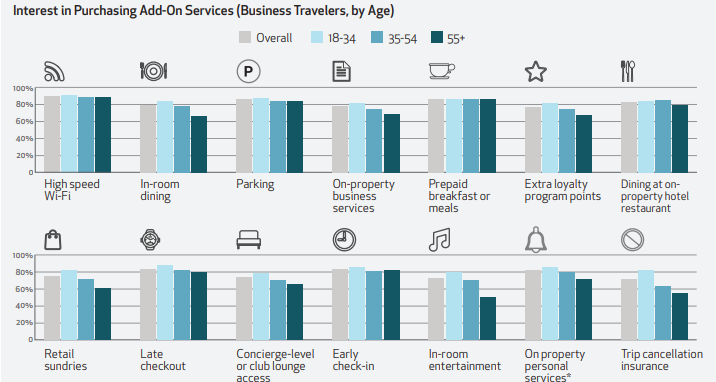
Interest in buying additional services by business travelers. Source: iSeatz
Ancillary revenue influences GOPPAR, so a hotel that offers packages will be much more profitable than one that doesn’t. There are internal and external packages. An internal package consists only of the items, produced, controlled, and offered by a hotel, for example, a wellness package that includes airport pick up, spa-service in a hotel, access to a gym, and a dinner at the hotel restaurant.
An external package entails offering third-party products and services, like car rental, transportation, or coupons/vouchers. For instance, travelers can book rooms with an airport-hotel transfer from a single interface; while a hotel receives a commission from the transfer partner. We’ve described how to include airport transfers in a booking engine in a related article. A hotel can choose a third party for cooperation or leverage a dynamic packaging platform, which is another revenue-increasing strategy.
6. Launch loyalty programs
Loyal customers are an indispensable part of increasing revenue. So, various loyalty programs for existing guests help retain people who already used your services. You can create targeted email campaigns with special offers for such customers.
Also, discounts can attract people who don’t know whether they should stay in a given hotel or not. For instance, with segment-based discounts for participants at a festival that takes place in your area, you can attract more guests.
Loyalty programs can be launched independently, or a hotel can join a network loyalty program like Stash Hotel Rewards or IHG. Depending on the hotel, guests can earn points for direct bookings or even passing on housekeeping. Then they can use earned points on other services or hotel stays. Such activities not only allow hotels to win a guest's trust, but also increase revenue: According to Cornell University’s School of Hotel Administration study, hotels that joined Stash Hotel Rewards experienced an almost 50 percent increase in annual room-nights for each guest and a 57 percent revenue gain per year.
7. Benchmark
Competition analysis or benchmarking is an important part of evaluating a hotel’s performance and position on the market. Typically, you’ll compare your indicators to that of your hotel’s compset, which would include properties with similar characteristics (e.g., location, number of rooms, amenities, etc.). Another option is benchmarking against industry leaders to identify your areas for improvement.
To get the information on how your competitors are performing, consider the STR report with data on thousands of properties around the world. Once you compare your KPIs and see where you stand, you might find opportunities for adjusting your pricing or distribution strategy to generate more revenue.
At AltexSoft, we worked on a tool that collects performance data of multiple properties and analyzes it. You can check the case study of the project.
When you monitor the situation on the market, you can choose if you want to be reactive or proactive. In the first case, you react to the market fluctuations and set prices accordingly. The advantage here is that you can outprice your competitors and make more appealing offers in reaction to theirs. If you decide to be proactive, you’ll have to get the most out of your data, make your own forecasts, and set rates yourself.
Revenue management challenges in the hospitality industry
Managing revenue and building effective strategies is a lengthy and laborious process. But time is not the only factor that adds up to the complexity. Here are the main revenue management-related challenges hoteliers face today.
Lack of experienced specialists. Revenue management is a highly intricate process that requires professionals with deep knowledge of the industry and exceptional skills in data analysis, consumer psychology, communication, and critical thinking.
Lack of technology. Without comprehensive software that is connected to other internal and external systems, it’s impossible to conduct efficient data analysis, get a holistic picture, and make data-driven strategic decisions. Transition from manual calculations or legacy systems to modern technologies is a major industry problem, especially for small and medium businesses. It requires investment, development effort, and more importantly, change of mindset.
Unstable demand and market conditions. The COVID-19 outbreak showed how unpredictable things can be. Consumer behavior, competition, and macroeconomic conditions are changing so rapidly that making accurate predictions is almost impossible. At the same time, revenue managers have to develop a long-term strategy and decide on pricing, distribution, and marketing well in advance (and under the pressure of realizing the costs of possible mistakes).
Distribution channels costs. When we talk about revenue, it’s not only about the incoming money flow, it’s also the expenses that matter. When developing a distribution strategy, it’s easy to overlook the costs that varied channels bring along. For example, paid ads on metasearch websites and social media increase the cost of direct bookings, but also improve brand awareness. Establishing the most effective mix of channels requires thorough analysis and close cooperation with the marketing and sales teams.
Lack of communication and trust. Changing the company culture is never easy. Managers of other departments might have a different vision of a company's strategy and development. And often, people with a traditional mindset don’t trust automated calculations and forecasts and prefer to make intuitive decisions. A revenue manager has to break through the internal silos and explain the effectiveness of actions and measures taken.

